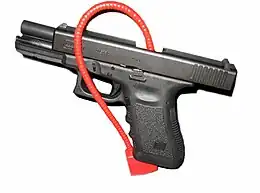Gun safety
Gun safety is the study and practice of using, transporting, storing and disposing of firearms and ammunition, including the training of gun users, the design of weapons, and formal and informal regulation of gun production, distribution, and usage, for the purpose of avoiding unintentional injury, illness, or death.[1] This includes mishaps like accidental discharge, negligent discharge, and firearm malfunctions, as well as secondary risks like hearing loss, lead poisoning from bullets, and pollution from other hazardous materials in propellants and cartridges. There were 47,000 unintentional firearm deaths worldwide in 2013.[2]
History
Accidental explosions of stored gunpowder date to the 13th century in Yangzhou, China.[3] Early handheld muskets using matchlock or wheel lock mechanisms were limited by poor reliability and the risk of accidental discharge, which was improved somewhat by the introduction of the flintlock, though unintentional firing continued to be a serious drawback. Percussion caps, introduced in the 1820s, were more reliable, and by 1830 inventors added security pins to their designs to prevent accidental discharges.[4] Trigger guards and grip safetys were further steps leading to the various safeties built into modern firearms.
Malfunctions
Storage
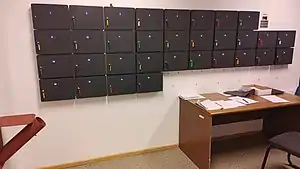
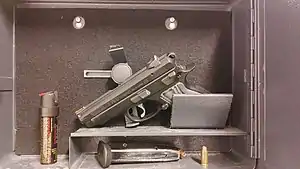
Proper storage prevents unauthorized use or theft of firearms and ammunition, or damage to them.[7] A gun safe or gun cabinet is commonly used to physically prevent access to a firearm. Local laws may require particular standards for the lock, for the strength and burglar resistance of the cabinet, and may even require weapons and ammunition to be stored separately. Rifles or shotgun safes that are a lighter version of true safes are generally the norm for hunters or multiple firearm owners. Various safety standards like the RSC standard and CDOJ safety standard in US exists for the minimum requirement to qualify a container as firearm safety storage device.[8] Similarly small handgun safes of different sizes and capacity are preferred for storing small number of handguns although most of them are found to be not very reliable by independent researchers and professional hackers. Locking mechanism plays important role in overall safety of the small safe. Generally simplex mechanical locks are found to be most secure and reliable.[9][10]
For ammunition some experts recommend storing in secure locations away from firearms.[11] Ammunition should be kept in cool, dry conditions free from contaminating vapors to prevent deterioration of the propellant and cartridge. Handloaders must take special precautions for storing primers and loose gunpowder.
Training, habits and mindset
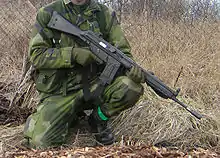
Gun safety training teaches a safety mindset, habits, and rules. The mindset is that firearms are inherently dangerous and must always be stored carefully and handled with care. Handlers are taught to treat firearms with respect for their destructive capabilities, and strongly discouraged from playing or toying with firearms, a common cause of accidents. The rules of gun safety follow from this mindset.
In 1902, the English politician and game shooting enthusiast Mark Hanbury Beaufoy wrote some much-quoted verses on gun safety, meant to instill the safety mindset. [12][13] Various similar sayings have since been popularized.[14][15] Jeff Cooper, an influential figure in modern firearms training, formalized and popularized "Four Rules" of safe firearm handling. Prior lists of gun safety rules included as few as three basic safety rules or as many as ten rules including gun safety and sporting etiquette rules. In addition to Cooper, other influential teachers of gun safety include Massad Ayoob, Clint Smith, Chuck Taylor, Jim Crews, Bob Munden and Ignatius Piazza.[16] Organisations such as The National Rifle Association of America provide similar sets of rules.[17][18]
Disassembly
Access to a functioning firearm can be prevented by keeping the firearm disassembled and the parts stored at separate locations. Sometimes, this rule is codified in law. For example, Swedish law requires firearms owners to store the entire firearm in a safe, classified by the authorities, i.e SS3492. The safe must also weigh more than 150 kilos empty. If it weighs less, it must be bolted to the floor and/or wall. Wall mounted, lockable gun racks are no longer permitted.
Locks
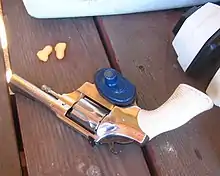
There are several types of locks that serve to make it difficult to discharge a firearm. Locks are considered less effective than keeping firearms stored in a lockable safe since locks are more easily defeated than approved safes. An unauthorized handler can bypass the locked firearm at their leisure.[7] Some manufacturers, such as Taurus, build locks into the firearm itself.
California effected regulations in 2000 that forced locks to be approved by a firearm safety device laboratory via California Penal Code Section 12088.[19] All locks under this code must receive extensive tests including saw, pick, pull, and many other tests in order to be approved for the state of California. If a lock passes the requirements then it is said to be California Department of Justice (CADOJ) approved.[20]
Trigger lock
Trigger locks prevent trigger manipulation, however they do not guarantee that the firearm absolutely cannot be discharged (see above). Some trigger locks are integrated into the design of the weapon, requiring no external parts besides the key.[21] Generally, two pieces come together from either side behind the trigger and are locked in place, which can be unlocked with a key or combination. This physically prevents the trigger from being depressed to discharge the weapon.[22] They may also form part of a larger padlock which locks the entire action.[22] Other more commercially common types of trigger locks do not go behind the trigger, but encompass the full area within the trigger guard to making the trigger inaccessible to users. Advanced models may also feature anti-tamper alarms.[21] A common critique of trigger locks is the time taken to unlock them, limiting their usefulness in a self-defense scenario. One potential solution to this is the use of biometric locks which can be removed by the owner near-instantaneously.[23][24]
There is controversy surrounding manufacturing standards, usage, and legislation of trigger locks. While supporters of trigger locks argue that they will save children by preventing accidents, critics point to demonstrations that some models can be removed by children with very little force and common household tools. Many firearms can discharge when dropped. Firearms that fully disengage the hammer when the safety is on pose less of a risk. Trigger locks are not designed for use on loaded firearms as the locking mechanism itself may be able manipulate the trigger if pressure is exerted on the lock or during installation/removal; critics argue that this may make the firearm more dangerous by creating the illusion of safety.[25] A former senior product manager at Master Lock, a trigger lock manufacturer, was quoted as saying "If it is a loaded gun, there isn't a lock out there that will keep it from being fired... If you put a trigger lock on any loaded gun, you are making the gun more dangerous."[26] Critics also point out that a trigger lock will increase the time it takes an owner to respond to a self-defense emergency. In 2008, the U.S. Supreme Court overturned a Washington, D.C. law that required handguns to be locked or otherwise kept inoperative within the home, saying that this "makes it impossible for citizens to use them for the core lawful purpose of self-defense".[27]
Although there are no universal standards for the design or testing of trigger locks, some jurisdictions, such as the state of California, maintain a list of approved trigger lock devices.[28] In Canada, a trigger lock is one of the methods prescribed by law to secure a firearm during transport or storage.[29]
Chamber locks
Chamber locks aim to block ammunition from being chambered, since most firearms typically cannot be discharged unless the ammunition is in the correct position. They are used to prevent live ammunition from being loaded into a firearm by blocking the chamber with a dummy cartridge or a chamber plug, which is sometimes wedged into place with the use of a tool, in essence jamming the firearm. Another type is one in which a steel rod locked into the safety cartridge with a key. As long as the rod and safety cartridge are engaged, the dummy round cannot eject nor can live ammunition be loaded into the firearm. Chamber locks work with most firearm types including revolvers, pistols, rifles and shotguns. They are available in any caliber and length, and may include such features as unique keying, rapid removal, and rigorous testing and certification by major state departments such as the California Department of Justice.
Some shooting ranges require the handler to insert a temporary chamber plug which often has a brightly colored external tag, to signal the chamber being devoid of ammunition and blocked, whenever the firearm is being unused. These are called empty chamber indicators, or chamber flags.
Cable locks
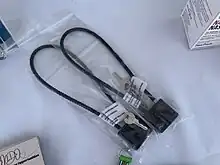
Cable locks are a popular type of lock that usually threads into the receiver through the ejection port of repeating firearms. These locks physically obstruct the movements of the bolt, thereby preventing the cycling of the action, and deny the return to "battery" and the closure of the breech. In many designs of pistol and rifle, they also thread through the magazine well of the firearm to prevent the proper insertion of a magazine.
Smart gun
Personalized firearms, or smart guns, are intended to prevent unauthorized use with built-in locks that are released by RFID chips or other proximity devices, fingerprint recognition, magnetic rings, or a microchip implant.[30]
Safety flag
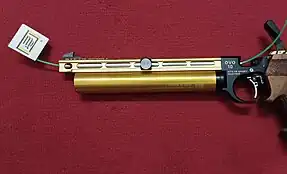
For reason of safety and security a rule of use of the safety flag has been strictly mentioned by ISSF for the 10m air pistol and rifle shooting sports events. The same rule goes for the higher distance shooting guns with much higher caliber of 25m with 0.22cal, 50m with 0.22cal, rapid fire pistol by 0.32cal and many other such sports shooting. Safety flag is a non metallic string with an identical end with a flag shaped object on it which sets on the front of the barrel. The string and the flag should be in such a color so that it is identical from distance that the gun is in safe mode. Safety flag is inserted inside the hollow barrel so that the bullet or the pallet cannot be inserted on the barrel and make it ready for firing. The thickness of the safety flag is being made in such measurement so that when it in inside the barrel, it will be impossible to get insert the pallet or the bullet inside the barrel. the It is removed only during the time of target firing. Not using the safety flag during the gun shooting sports makes the contest participant shooter disqualified.[31]
"A Rule for Shooting"
Never, never let your gun
Pointed be at anyone.
All the pheasants ever bred
Won't make up for one man dead.— Anonymous, The Faber Book of Useful Verse (1981), p. 249.
Secondary dangers
While a firearm's primary danger lies in the discharge of ammunition, there are other ways a firearm may be detrimental to the health of the handler and bystanders.
Noise
When a firearm is discharged it emits a very loud noise, typically close to the handler's ears. This can cause temporary or permanent hearing damage such as tinnitus. Hearing protection such as earplugs, or earmuffs, or both, can reduce the risk of hearing damage.[7] Some earmuffs or headphones made for shooting and similar loud situations use active noise control. Firearms may also have silencers which reduce the sound intensity from the barrel.
Hot gases and debris
A firearm emits hot gases, powder, and other debris when discharged. Some firearms, such as semi-automatic and fully automatic firearms, typically eject spent cartridge casings at high speed. Casings are also dangerously hot when ejected. Revolvers store spent casings in the chamber, but may emit a stream of hot gases and possible fine particulate debris laterally from the interface between the revolving chamber and the barrel. Any of these may hurt the handler or bystanders through burning or impact damage. Because eyes are particularly vulnerable to this type of damage, eye protection should be worn to reduce the risk of injury. Prescription lenses and various tints to suit different light conditions are available.[7] Some eye protection products are rated to withstand impact from birdshot loads, which offers protection against irresponsible firearms use by other game bird shooters.[32]
Toxins and pollutants
In recent years the toxic effects of ammunition and firearm cleaning agents have been highlighted.
- Lead ammunition left in nature may become mobilized by acid rain.
- Older ammunition may have mercury-based primers.
- Lead accumulates in shooting range backstops.
Indoor ranges require good ventilation to remove pollutants such as powder, smoke, and lead dust from the air around the shooters. Indoor and outdoor ranges typically require extensive decontamination when they are decommissioned to remove all traces of lead, copper, and powder residues from the area.
Lead, copper and other metals will also be released when a firearm is cleaned. Highly aggressive solvents and other agents used to remove lead and powder fouling may also present a hazard to health. Installing good ventilation, washing hands after handling firearms, and cleaning the space where the firearm was handled lessens the risk of unnecessary exposure.
Unsafe users
Impaired users
Firearms should never be handled by persons who are under the influence of alcohol or any drugs which may affect their judgment. Gun safety teachers advocate zero tolerance of their use.[33] In the United States, this recommendation is codified in many states' penal codes as a crime of "carrying under the influence", with penalties similar to DWI/DUI.[34] Other sources of temporary impairment include exhaustion, dehydration, and emotional stress. These can affect reaction time, cognitive processing, sensory perception, and judgment.[35]
Many jurisdictions prohibit the possession of firearms by people deemed generally incapable of using them safely, such as the mentally ill or convicted felons.
Children
The National Rifle Association of America's Eddie Eagle program for preschoolers through 6th graders is intended to teach children to avoid firearm accidents when they encounter guns that have not been securely stored out of their reach.[36]
Whether programs like Eddie Eagle are effective has not been conclusively determined. Some studies published in peer-reviewed journals have shown that it is very difficult for young children to control their curiosity even when they have been taught not to touch firearms.[37] Gun access is also a major risk factor for youth suicide.[38] The American Academy of Pediatrics (AAP) advises that keeping a gun in the home, especially a handgun, increases the risk of injury and death for children and youth in the home.[39]
See also
References
- Fell's guide to guns and how to use them safely, legally, responsibly, Hardcover – January 1, 1969 by Byron G Wels (Author), ASIN: B0006BZEFY, Publisher: F. Fell; 0 edition (January 1, 1969), Language: English, Hardcover: 173 pages
- Naghavi, Mohsen; et al. (17 December 2014). "Global, regional, and national age-sex specific all-cause and cause-specific mortality for 240 causes of death, 1990–2013: a systematic analysis for the Global Burden of Disease Study 2013". The Lancet. 385 (9963): 117–71. doi:10.1016/S0140-6736(14)61682-2. PMC 4340604. PMID 25530442.
- Andrade, Tonio (2016), The Gunpowder Age China, Military Innovation, and the Rise of the West in World History, p. 15, ISBN 9781400874446
- Hebert, Luke (1830). The Register of arts, and journal of patent inventions, ed. By L. Herbert. Vol. 4.
- "NRA GUN SAFETY RULES". Archived from the original on 18 May 2023. Retrieved 10 March 2017.
- Findley, Ben (21 February 2014). "Handgun Malfunctions and Stoppages". usacarry.com. Archived from the original on 25 July 2022. Retrieved 10 March 2017.
- Carolee Boyles. "Safety sells - safety devices for gun owners and their firearms". Shooting Industry. Archived from the original on 30 October 2004.
- "Rscs built like true safes". 6 November 2020. Archived from the original on 14 December 2022. Retrieved 15 July 2021.
- "Small gun safe brands to avoid". 6 November 2020. Archived from the original on 14 December 2022. Retrieved 15 July 2021.
- "Handgun safe research". Archived from the original on 16 May 2023. Retrieved 15 July 2021.
- GAO (1991). Accidental Shootings: Many Deaths and Injuries Caused by Firearms Could Be Prevented. p. 35. ISBN 9781568065533.
- Rose, R. N. (22 November 1956). The BEAUFOY VERSES, in The Field. Archived from the original on 1 August 2009. Retrieved 29 June 2008.
- Beaufoy, Gwendolyn (1930). Leaves from a Beech Tree. Oxford, Printed for the author by B. Blackwell, 1930.
- Reeves, Ira L. (1913). The A B C of Rifle, Revolver and Pistol Shooting. Kansas City, Missouri: Franklin Hudson Publishing Company. p. 10.
- "The Ten Commandments of Safety". Sporting Shooters’ Association of Australia. Archived from the original on 8 January 2015. Retrieved 28 January 2015.
- Morrison, Gregory Boyce (1991). Cooper, Jeff (ed.). The Modern Technique of the Pistol. Paulden, Arizona, USA: Gunsite Press. ISBN 978-0-9621342-3-4. LCCN 91072644.
- "NRA Gun Safety Rules". The National Rifle Association of America. 2018. Archived from the original on 12 March 2017. Retrieved 7 June 2018.
- "13 Universal gun safety tips". Archived from the original on 4 January 2023. Retrieved 14 December 2022.
- "Aroner-Scott-Hayden Firearms Safety Act of 1999". State of California. 1999. Archived from the original on 4 July 2009. Retrieved 18 May 2009.
- "Pro-Lok: Professional Quality Tools - CADOJ REGULATIONS". PRO-LOK. 2007–2009. Archived from the original on 11 July 2011. Retrieved 18 May 2009.
- "Types of locks and where to buy them". King County. 11 October 2019. Archived from the original on 10 June 2023.
- Joseph, Alex (26 April 2020). "Should You Get A Trigger Lock or a Cable Lock On Your Gun?". The National Interest. Archived from the original on 10 December 2022. Retrieved 22 May 2022.
- "Identilock Fingerprint Trigger Locks Solve the Self-defense Dichotomy". American Outdoor Guide. 24 May 2019. Archived from the original on 1 December 2022. Retrieved 22 May 2022.
- Bi, Frank (8 January 2016). "Can this smart lock solve America's gun troubles?". The Verge. Archived from the original on 9 February 2023. Retrieved 22 May 2022.
- Peters, Justin (18 July 2013). "Trigger Locks, the Dubiously Effective Safety Measure That Gun Control Advocates Love". Slate Magazine. Archived from the original on 30 May 2023. Retrieved 22 May 2022.
- Slater, Eric (16 February 1999). "Hype Over Trigger Locks Provokes Fear of Firearm Accidents". Los Angeles Times. Archived from the original on 2 June 2023. Retrieved 3 March 2009.
- Egelco, Bob (27 June 2008). "RULING'S RICOCHET - A right to own guns: Supreme Court defines 2nd Amendment - gun lobby expected to challenge S.F. ban on handgun possession in public housing". San Francisco Chronicle. Archived from the original on 1 July 2008. Retrieved 3 March 2009.
- California DOJ Bureau of Firearms (6 May 2008). "Approved Firearms Safety Devices Compability Chart" (PDF). Archived from the original (PDF) on 9 July 2008. Retrieved 16 May 2008.
- Royal Canadian Mounted Police. "Storing, Transporting, and Displaying Firearms". Archived from the original on 20 August 2007. Retrieved 16 May 2008.
- "No Chip in Arm, No Shot From Gun". Wired. 14 April 2004. Archived from the original on 9 March 2021. Retrieved 4 August 2012.
- https://www.issf-sports.org/getfile.aspx?mod=docf&pane=1&inst=31&iist=26&file=Training_Manual_Pistol_for_ISSF_Range_Officials_and_Judges_-_Edition_2018.pdf
- Roy Huntington. "Gun safety & safety products". Shooting Industry. Archived from the original on 8 July 2012.
- "Gun Safety Rules; Save a life by reading this page and give it to a friend". www.SaveTheGuns.com. 2000–2009. Archived from the original on 2 June 2023. Retrieved 18 May 2009.
- "MSP - Carrying Under the Influence". State of Michigan. 2001–2009. Archived from the original on 26 March 2023. Retrieved 18 May 2009.
- "ARTICLE 36: PROHIBITING THE CARRYING OF A FIREARM WHILE UNDER THE INFLUENCE OF AN ALCOHOLIC BEVERAGE OR DRUG, OR POSSESSION OF A FIREARM WHILE UPON PUBLIC PREMISES SELLING OR SERVING ALCOHOLIC BEVERAGES". City and County of San Francisco. 23 June 2023. Retrieved 30 July 2023.
Persons under the influence of an alcoholic beverage or drug frequently lack the normal restraint and judgment that would ordinarily prevent them from initiating or escalating criminal or domestic violence.
- "Eddie Eagle Safety Program". The National Rifle Association of America. 2009. Archived from the original on 1 June 2023. Retrieved 18 May 2009.
- "Gun Safety for Kids and Youth - What if I've taught my kids not to touch a gun if they find one?". University of Michigan Health System. 2010. Archived from the original on 14 February 2023. Retrieved 13 January 2012.
- "Suicide-Proof Your Home". The Center to Prevent Youth Violence. 2011. Archived from the original on 21 February 2012. Retrieved 13 January 2012.
- "Gun Safety: Keeping Children Safe". The American Academy of Pediatrics. 2012. Archived from the original on 4 June 2023. Retrieved 13 January 2012.
